XCO2 Super-Resolution Reconstruction Based on Spatial Extreme Random Trees
Abstract
1. Introduction
- (1)
- Incorporating spatial information into the extreme random trees model, which integrates the advantages of machine learning methods and spatial features, enhancing the predictive performance of the model. This model can offer novel approaches for the high-resolution reconstruction of diverse geographical data.
- (2)
- Utilizing the constructed model to reconstruct a 1 km high-resolution XCO2 dataset for China from 2016 to 2020.
- (3)
- Based on the predicted results, identifying and analyzing the spatiotemporal patterns of XCO2 within the Chinese region. These long-term, high-resolution XCO2 data contribute to our understanding of the spatiotemporal distribution characteristics of and variations in XCO2, thus improving the formulation of policies and strategies for carbon emission reduction.
2. Materials and Methods
2.1. Study Area
2.2. XCO2 Data
2.3. Influencing Factors
2.4. Data Processing
2.5. Spatial Extreme Random Trees
3. Results
3.1. Model Comparison
3.2. Spatial Extreme Random Trees Validation
3.3. Spatiotemporal Variations in XCO2 in China
4. Conclusions
- (1)
- The SExtraTrees model proposed in this study is an effective technique for predicting national long-term time series XCO2 data. The SExtraTrees model outperforms Kriging interpolation and extreme random trees models in terms of model fitting and prediction while maintaining spatial consistency with the original XCO2 data and ensuring high predictive accuracy.
- (2)
- The 1 km-resolution XCO2 products reconstructed using the spatial extreme random trees model provide fundamental data and technical support for regional XCO2 monitoring. These predicted XCO2 datasets can also serve as a reference for calibrating other low-resolution XCO2 datasets. The obtained results highlight the importance of combining geographic spatial correlations with machine learning methods to achieve high precision and robustness. The spatial extreme random trees model can also be applied to the resolution reconstruction of other environmental factors.
- (3)
- Based on the resolution reconstruction results of the spatial extreme random trees model, XCO2 exhibits significant spatial and temporal heterogeneity. From 2016 to 2020, XCO2 in China shows an increasing trend each year. Nationally, the spatial distribution of XCO2 aligns with China’s economic development and urbanization level, with higher XCO2 concentrations in the eastern regions and lower concentrations in the western regions of China. The distribution of carbon concentrations varies among different regions, mainly due to differences in the geographical environment, economic development level, and industrial structure. Higher vegetation coverage can enhance the carbon sequestration capacity. Given the spatiotemporal changes and differences in XCO2, this study provides scientific references for reducing carbon emissions, which is essential for crafting efficient policies aimed at reducing carbon emissions and addressing climate change.
Author Contributions
Funding
Institutional Review Board Statement
Informed Consent Statement
Data Availability Statement
Conflicts of Interest
References
- Caminade, C.; McIntyre, K.M.; Jones, A.E. Impact of recent and future climate change on vector-borne diseases. Ann. N. Y. Acad. Sci. 2019, 1436, 157–173. [Google Scholar] [CrossRef] [PubMed]
- Hao, Y.; Chen, H.; Wei, Y.-M.; Li, Y.-M. The influence of climate change on CO2 (carbon dioxide) emissions: An empirical estimation based on Chinese provincial panel data. J. Clean. Prod. 2016, 131, 667–677. [Google Scholar] [CrossRef]
- Quadrelli, R.; Peterson, S. The energy–climate challenge: Recent trends in CO2 emissions from fuel combustion. Energy Policy 2007, 35, 5938–5952. [Google Scholar] [CrossRef]
- Montzka, S.A.; Dlugokencky, E.J.; Butler, J.H. Non-CO2 greenhouse gases and climate change. Nature 2011, 476, 43–50. [Google Scholar] [CrossRef] [PubMed]
- Holland, D.M.; Thomas, R.H.; de Young, B.; Ribergaard, M.H.; Lyberth, B. Acceleration of Jakobshavn Isbræ triggered by warm subsurface ocean waters. Nat. Geosci. 2008, 1, 659–664. [Google Scholar] [CrossRef]
- Sellers, P.J.; Schimel, D.S.; Moore, B., 3rd; Liu, J.; Eldering, A. Observing carbon cycle-climate feedbacks from space. Proc. Natl. Acad. Sci. USA 2018, 115, 7860–7868. [Google Scholar] [CrossRef] [PubMed]
- Solomon, S.; Plattner, G.-K.; Knutti, R.; Friedlingstein, P. Irreversible climate change due to carbon dioxide emissions. Proc. Natl. Acad. Sci. USA 2009, 106, 1704–1709. [Google Scholar] [CrossRef] [PubMed]
- Scholze, M.; Knorr, W.; Arnell, N.W.; Prentice, I.C. A climate-change risk analysis for world ecosystems. Proc. Natl. Acad. Sci. USA 2006, 103, 13116–13120. [Google Scholar] [CrossRef] [PubMed]
- Yu, K.M.; Curcic, I.; Gabriel, J.; Tsang, S.C. Recent advances in CO2 capture and utilization. ChemSusChem 2008, 1, 893–899. [Google Scholar] [CrossRef] [PubMed]
- Yu, C.-H.; Huang, C.-H.; Tan, C.-S. A Review of CO2 Capture by Absorption and Adsorption. Aerosol Air Qual. Res. 2012, 12, 745–769. [Google Scholar] [CrossRef]
- Jimenez, V.; Ramirez-Lucas, A.; Diaz, J.A.; Sanchez, P.; Romero, A. CO2 capture in different carbon materials. Environ. Sci. Technol. 2012, 46, 7407–7414. [Google Scholar] [CrossRef] [PubMed]
- Ajayi, T.; Gomes, J.S.; Bera, A. A review of CO2 storage in geological formations emphasizing modeling, monitoring and capacity estimation approaches. Pet. Sci. 2019, 16, 1028–1063. [Google Scholar] [CrossRef]
- Labzovskii, L.D.; Mak, H.W.L.; Takele Kenea, S.; Rhee, J.-S.; Lashkari, A.; Li, S.; Goo, T.-Y.; Oh, Y.-S.; Byun, Y.-H. What can we learn about effectiveness of carbon reduction policies from interannual variability of fossil fuel CO2 emissions in East Asia? Environ. Sci. Policy 2019, 96, 132–140. [Google Scholar] [CrossRef]
- Potier, E.; Broquet, G.; Wang, Y.; Santaren, D.; Berchet, A.; Pison, I.; Marshall, J.; Ciais, P.; Bréon, F.-M.; Chevallier, F. Complementing XCO2 imagery with ground-based CO2 and 14CO2 measurements to monitor CO2 emissions from fossil fuels on a regional to local scale. Atmos. Meas. Tech. 2022, 15, 5261–5288. [Google Scholar] [CrossRef]
- Rothenberg, G. A realistic look at CO2 emissions, climate change and the role of sustainable chemistry. Sustain. Chem. Clim. Action 2023, 2, 100012. [Google Scholar] [CrossRef]
- Finkbeiner, M.; Bach, V. Life cycle assessment of decarbonization options—Towards scientifically robust carbon neutrality. Int. J. Life Cycle Assess. 2021, 26, 635–639. [Google Scholar] [CrossRef]
- Gil, L.; Bernardo, J. An approach to energy and climate issues aiming at carbon neutrality. Renew. Energy Focus 2020, 33, 37–42. [Google Scholar] [CrossRef]
- Ciais, P.; Dolman, A.J.; Bombelli, A.; Duren, R.; Peregon, A.; Rayner, P.J.; Miller, C.; Gobron, N.; Kinderman, G.; Marland, G.; et al. Current systematic carbon-cycle observations and the need for implementing a policy-relevant carbon observing system. Biogeosciences 2014, 11, 3547–3602. [Google Scholar] [CrossRef]
- Wunch, D.; Toon, G.C.; Blavier, J.F.; Washenfelder, R.A.; Notholt, J.; Connor, B.J.; Griffith, D.W.; Sherlock, V.; Wennberg, P.O. The total carbon column observing network. Philos. Trans. A Math. Phys. Eng. Sci. 2011, 369, 2087–2112. [Google Scholar] [CrossRef]
- Chevallier, F.; Deutscher, N.M.; Conway, T.J.; Ciais, P.; Ciattaglia, L.; Dohe, S.; Fröhlich, M.; Gomez-Pelaez, A.J.; Griffith, D.; Hase, F.; et al. Global CO2fluxes inferred from surface air-sample measurements and from TCCON retrievals of the CO2total column. Geophys. Res. Lett. 2011, 38. [Google Scholar] [CrossRef]
- Heiskanen, J.; Brümmer, C.; Buchmann, N.; Calfapietra, C.; Chen, H.; Gielen, B.; Gkritzalis, T.; Hammer, S.; Hartman, S.; Herbst, M.; et al. The Integrated Carbon Observation System in Europe. Bull. Am. Meteorol. Soc. 2022, 103, E855–E872. [Google Scholar] [CrossRef]
- Shiga, Y.P.; Michalak, A.M.; Randolph Kawa, S.; Engelen, R.J. In-situ CO2 monitoring network evaluation and design: A criterion based on atmospheric CO2 variability. J. Geophys.Res. Atmos. 2013, 118, 2007–2018. [Google Scholar] [CrossRef]
- Siabi, Z.; Falahatkar, S.; Alavi, S.J. Spatial distribution of XCO(2) using OCO-2 data in growing seasons. J. Environ. Manag. 2019, 244, 110–118. [Google Scholar] [CrossRef]
- Pan, G.; Xu, Y.; Ma, J. The potential of CO(2) satellite monitoring for climate governance: A review. J. Environ. Manag. 2021, 277, 111423. [Google Scholar] [CrossRef] [PubMed]
- Wang, Y.; Wang, M.; Teng, F.; Ji, Y. Remote Sensing Monitoring and Analysis of Spatiotemporal Changes in China’s Anthropogenic Carbon Emissions Based on XCO2 Data. Remote Sens. 2023, 15, 3207. [Google Scholar] [CrossRef]
- Lu, S.; Wang, J.; Wang, Y.; Yan, J. Analysis on the variations of atmospheric CO2 concentrations along the urban–rural gradients of Chinese cities based on the OCO-2 XCO2 data. Int. J. Remote Sens. 2018, 39, 4194–4213. [Google Scholar] [CrossRef]
- Hakkarainen, J.; Ialongo, I.; Maksyutov, S.; Crisp, D. Analysis of Four Years of Global XCO2 Anomalies as Seen by Orbiting Carbon Observatory-2. Remote Sens. 2019, 11, 850. [Google Scholar] [CrossRef]
- Cogan, A.J.; Boesch, H.; Parker, R.J.; Feng, L.; Palmer, P.I.; Blavier, J.F.L.; Deutscher, N.M.; Macatangay, R.; Notholt, J.; Roehl, C.; et al. Atmospheric carbon dioxide retrieved from the Greenhouse gases Observing SATellite (GOSAT): Comparison with ground-based TCCON observations and GEOS-Chem model calculations. J. Geophys. Res. Atmos. 2012, 117, D21. [Google Scholar] [CrossRef]
- Crisp, D.; Pollock, H.R.; Rosenberg, R.; Chapsky, L.; Lee, R.A.M.; Oyafuso, F.A.; Frankenberg, C.; O’Dell, C.W.; Bruegge, C.J.; Doran, G.B.; et al. The on-orbit performance of the Orbiting Carbon Observatory-2 (OCO-2) instrument and its radiometrically calibrated products. Atmos. Meas. Tech. 2017, 10, 59–81. [Google Scholar] [CrossRef]
- Sheng, M.; Lei, L.; Zeng, Z.-C.; Rao, W.; Song, H.; Wu, C. Global land 1° mapping dataset of XCO2 from satellite observations of GOSAT and OCO-2 from 2009 to 2020. Big Earth Data 2022, 7, 170–190. [Google Scholar] [CrossRef]
- Liu, Y.; Wang, J.; Yao, L.; Chen, X.; Cai, Z.; Yang, D.; Yin, Z.; Gu, S.; Tian, L.; Lu, N.; et al. The TanSat mission: Preliminary global observations. Sci. Bull. 2018, 63, 1200–1207. [Google Scholar] [CrossRef] [PubMed]
- Kuhlmann, G.; Brunner, D.; Broquet, G.; Meijer, Y. Quantifying CO2 emissions of a city with the Copernicus Anthropogenic CO2 Monitoring satellite mission. Atmos. Meas. Tech. 2020, 13, 6733–6754. [Google Scholar] [CrossRef]
- Ruonan, P.; Liang, A.; Xinyü, L.; Xinjie, L.J.R.S.T. High Spatio-temporal Resolution XCO2 Data Interpolation Algorithm based on OCO-2/3 Satellite. Remote Sens. Technol. Appl. 2023, 38, 614–623. [Google Scholar]
- Jing, Y.; Shi, J.; Wang, T.; Sussmann, R. Mapping Global Atmospheric CO2 Concentration at High Spatiotemporal Resolution. Atmosphere 2014, 5, 870–888. [Google Scholar] [CrossRef]
- Zeng, Z.-C.; Lei, L.; Strong, K.; Jones, D.B.A.; Guo, L.; Liu, M.; Deng, F.; Deutscher, N.M.; Dubey, M.K.; Griffith, D.W.T.; et al. Global land mapping of satellite-observed CO2 total columns using spatio-temporal geostatistics. Int. J. Digit. Earth 2016, 10, 426–456. [Google Scholar] [CrossRef]
- Hammerling, D.M.; Michalak, A.M.; Kawa, S.R. Mapping of CO2 at high spatiotemporal resolution using satellite observations: Global distributions from OCO-2. J. Geophys.Res. Atmos. 2012, 117. [Google Scholar] [CrossRef]
- Mousavi, S.M.; Dinan, N.M.; Ansarifard, S.; Sonnentag, O. Analyzing spatio-temporal patterns in atmospheric carbon dioxide concentration across Iran from 2003 to 2020. Atmos.Environ. X 2022, 14, 100163. [Google Scholar] [CrossRef]
- Bhattacharjee, S.; Dill, K.; Chen, J. Forecasting Interannual Space-based CO2 Concentration using Geostatistical Mapping Approach. In Proceedings of the 2020 IEEE International Conference on Electronics, Computing and Communication Technologies (CONECCT), Bangalore, India, 2–4 July 2020; pp. 1–6. [Google Scholar]
- He, Z.; Lei, L.; Zhang, Y.; Sheng, M.; Wu, C.; Li, L.; Zeng, Z.-C.; Welp, L.R. Spatio-Temporal Mapping of Multi-Satellite Observed Column Atmospheric CO2 Using Precision-Weighted Kriging Method. Remote Sens. 2020, 12, 576. [Google Scholar] [CrossRef]
- Mousavi, S.M.; Dinan, N.M.; Ansarifard, S.; Borhani, F.; Ezimand, K.; Naghibi, A. Examining the Role of the Main Terrestrial Factors Won the Seasonal Distribution of Atmospheric Carbon Dioxide Concentration over Iran. J. Indian Soc. Remote Sens. 2023, 51, 865–875. [Google Scholar] [CrossRef]
- Golkar, F.; Mousavi, S.M. Variation of XCO2 anomaly patterns in the Middle East from OCO-2 satellite data. Int. J. Digit. Earth 2022, 15, 1219–1235. [Google Scholar] [CrossRef]
- Liang, A.; Pang, R.; Chen, C.; Xiang, C. XCO2 Fusion Algorithm Based on Multi-Source Greenhouse Gas Satellites and CarbonTracker. Atmosphere 2023, 14, 1335. [Google Scholar] [CrossRef]
- Zhao, Z.; Xie, F.; Ren, T.; Zhao, C. Atmospheric CO2retrieval from satellite spectral measurements by a two-step machine learning approach. J. Quant. Spectrosc. Radiat. Transf. 2022, 278, 108006. [Google Scholar] [CrossRef]
- Mohammadi, F.; Teiri, H.; Hajizadeh, Y.; Abdolahnejad, A.; Ebrahimi, A. Prediction of atmospheric PM(2.5) level by machine learning techniques in Isfahan, Iran. Sci. Rep. 2024, 14, 2109. [Google Scholar] [CrossRef] [PubMed]
- Mak, H.W.L. Improved Remote Sensing Algorithms and Data Assimilation Approaches in Solving Environmental Retrieval Problems; Hong Kong University of Science and Technology: Hong Kong, China, 2019. [Google Scholar]
- He, C.; Ji, M.; Li, T.; Liu, X.; Tang, D.; Zhang, S.; Luo, Y.; Grieneisen, M.L.; Zhou, Z.; Zhan, Y. Deriving Full-Coverage and Fine-Scale XCO2 Across China Based on OCO-2 Satellite Retrievals and CarbonTracker Output. Geophys. Res. Lett. 2022, 49, e2022GL098435. [Google Scholar] [CrossRef]
- Wang, W.; He, J.; Feng, H.; Jin, Z. High-Coverage Reconstruction of XCO(2) Using Multisource Satellite Remote Sensing Data in Beijing-Tianjin-Hebei Region. Int. J. Environ. Res. Public Health 2022, 19, 10853. [Google Scholar] [CrossRef] [PubMed]
- He, S.; Yuan, Y.; Wang, Z.; Luo, L.; Zhang, Z.; Dong, H.; Zhang, C. Machine Learning Model-Based Estimation of XCO2 with High Spatiotemporal Resolution in China. Atmosphere 2023, 14, 436. [Google Scholar] [CrossRef]
- Hastie, T.; Tibshirani, R.; Friedman, J. Random Forests. In The Elements of Statistical Learning; Springer Series in Statistics; Springer: Berlin/Heidelberg, Germany, 2009; pp. 1–18. [Google Scholar]
- Chen, T.; Guestrin, C. XGBoost. In Proceedings of the 22nd ACM SIGKDD International Conference on Knowledge Discovery and Data Mining, San Francisco, CA, USA, 13–17 August 2016; pp. 785–794. [Google Scholar]
- Cheng, J.; Li, G.; Chen, X. Research on Travel Time Prediction Model of Freeway Based on Gradient Boosting Decision Tree. IEEE Access 2019, 7, 7466–7480. [Google Scholar] [CrossRef]
- Geurts, P.; Ernst, D.; Wehenkel, L. Extremely randomized trees. Mach. Learn. 2006, 63, 3–42. [Google Scholar] [CrossRef]
- Wu, C.; Ju, Y.; Yang, S.; Zhang, Z.; Chen, Y. Reconstructing annual XCO(2) at a 1 kmx1 km spatial resolution across China from 2012 to 2019 based on a spatial CatBoost method. Environ Res 2023, 236, 116866. [Google Scholar] [CrossRef]
- Li, T.; Wu, J.; Wang, T. Generating daily high-resolution and full-coverage XCO(2) across China from 2015 to 2020 based on OCO-2 and CAMS data. Sci. Total Environ. 2023, 893, 164921. [Google Scholar] [CrossRef]
- Li, H.; Mu, H.; Zhang, M.; Li, N. Analysis on influence factors of China’s CO2 emissions based on Path–STIRPAT model. Energy Policy 2011, 39, 6906–6911. [Google Scholar] [CrossRef]
- Liu, K.; Xue, M.; Peng, M.; Wang, C. Impact of spatial structure of urban agglomeration on carbon emissions: An analysis of the Shandong Peninsula, China. Technol. Forecast. Soc. Chang. 2020, 161, 120313. [Google Scholar] [CrossRef]
- Dong, K.; Hochman, G.; Zhang, Y.; Sun, R.; Li, H.; Liao, H. CO2 emissions, economic and population growth, and renewable energy: Empirical evidence across regions. Energy Econ. 2018, 75, 180–192. [Google Scholar] [CrossRef]
- Sun, H.; Li, M.; Xue, Y. Examining the Factors Influencing Transport Sector CO2 Emissions and Their Efficiency in Central China. Sustainability 2019, 11, 4712. [Google Scholar] [CrossRef]
- Gudipudi, R.; Fluschnik, T.; Ros, A.G.C.; Walther, C.; Kropp, J.P. City density and CO2 efficiency. Energy Policy 2016, 91, 352–361. [Google Scholar] [CrossRef]
- Sun, B.; Han, S.; Li, W. Effects of the polycentric spatial structures of Chinese city regions on CO2 concentrations. Transp. Res. Part D Transp. Environ. 2020, 82, 102333. [Google Scholar] [CrossRef]
- Borck, R.; Schrauth, P. Population density and urban air quality. Reg. Sci. Urban Econ. 2021, 86, 103596. [Google Scholar] [CrossRef]
- Moehl, J.; Reith, A.; McKee, J.; Weber, E.; Laverdiere, M.; Swan, B.; Yang, H.; Hauser, T.; Rose, A.; Walters, S.; et al. LandScan HD China v1.0; Oak Ridge National Laboratory: Oak Ridge, TN, USA, 2023. [Google Scholar] [CrossRef]
- Zhang, H.; Peng, J.; Wang, R.; Zhang, J.; Yu, D. Spatial planning factors that influence CO2 emissions: A systematic literature review. Urban Clim. 2021, 36, 100809. [Google Scholar] [CrossRef]
- Han, J.; Meng, X.; Liang, H.; Cao, Z.; Dong, L.; Huang, C. An improved nightlight-based method for modeling urban CO2 emissions. Environ. Model. Softw. 2018, 107, 307–320. [Google Scholar] [CrossRef]
- Du, X.; Shen, L.; Wong, S.W.; Meng, C.; Yang, Z. Night-time light data based decoupling relationship analysis between economic growth and carbon emission in 289 Chinese cities. Sustain. Cities Soc. 2021, 73, 103119. [Google Scholar] [CrossRef]
- Liu, X.; Ou, J.; Wang, S.; Li, X.; Yan, Y.; Jiao, L.; Liu, Y. Estimating spatiotemporal variations of city-level energy-related CO2 emissions: An improved disaggregating model based on vegetation adjusted nighttime light data. J. Clean. Prod. 2018, 177, 101–114. [Google Scholar] [CrossRef]
- Xu, X. China Annual Vegetation Index (NDVI) Spatial Distribution Dataset. In Data Registration and Publishing System of the Resource and Environmental Science Data Center; Chinese Academy of Sciences: Beijing, China, 2018. [Google Scholar] [CrossRef]
- Li, X.; Xiao, J. Mapping Photosynthesis Solely from Solar-Induced Chlorophyll Fluorescence: A Global, Fine-Resolution Dataset of Gross Primary Production Derived from OCO-2. Remote Sens. 2019, 11, 2563. [Google Scholar] [CrossRef]
- Poll, C.; Marhan, S.; Back, F.; Niklaus, P.A.; Kandeler, E. Field-scale manipulation of soil temperature and precipitation change soil CO2 flux in a temperate agricultural ecosystem. Agric. Ecosyst. Environ. 2013, 165, 88–97. [Google Scholar] [CrossRef]
- Wu, J.; Xia, L.; On Chan, T.; Awange, J.; Zhong, B. Downscaling land surface temperature: A framework based on geographically and temporally neural network weighted autoregressive model with spatio-temporal fused scaling factors. ISPRS J. Photogramm. Remote Sens. 2022, 187, 259–272. [Google Scholar] [CrossRef]
- Perez, I.A.; Garcia, M.L.A.; Sanchez, M.L.; Pardo, N. Influence of Wind Speed on CO2 and CH4 Concentrations at a Rural Site. Int. J. Environ. Res. Public Health 2021, 18, 8397. [Google Scholar] [CrossRef] [PubMed]
- Peng, S.; Ding, Y.; Liu, W.; Li, Z. 1 km monthly temperature and precipitation dataset for China from 1901 to 2017. Earth Syst. Sci. Data 2019, 11, 1931–1946. [Google Scholar] [CrossRef]
- Xu, X. China Annual Spatial Interpolation Dataset of Meteorological Elements. In Resource and Environmental Science Data Registration and Publishing System; Resource and Environmental Science and Data Center: Beijing, China, 2022. [Google Scholar] [CrossRef]
- Zhang, L.; Li, T.; Wu, J. Deriving gapless CO2 concentrations using a geographically weighted neural network: China, 2014–2020. Int. J. Appl. Earth Obs. Geoinf. 2022, 114, 103063. [Google Scholar] [CrossRef]
- Lv, Z.; Shi, Y.; Zang, S.; Sun, L. Spatial and Temporal Variations of Atmospheric CO2 Concentration in China and Its Influencing Factors. Atmosphere 2020, 11, 231. [Google Scholar] [CrossRef]
- Sheng, M.; Lei, L.; Zeng, Z.-C.; Rao, W.; Zhang, S. Detecting the Responses of CO2 Column Abundances to Anthropogenic Emissions from Satellite Observations of GOSAT and OCO-2. Remote Sens. 2021, 13, 3524. [Google Scholar] [CrossRef]
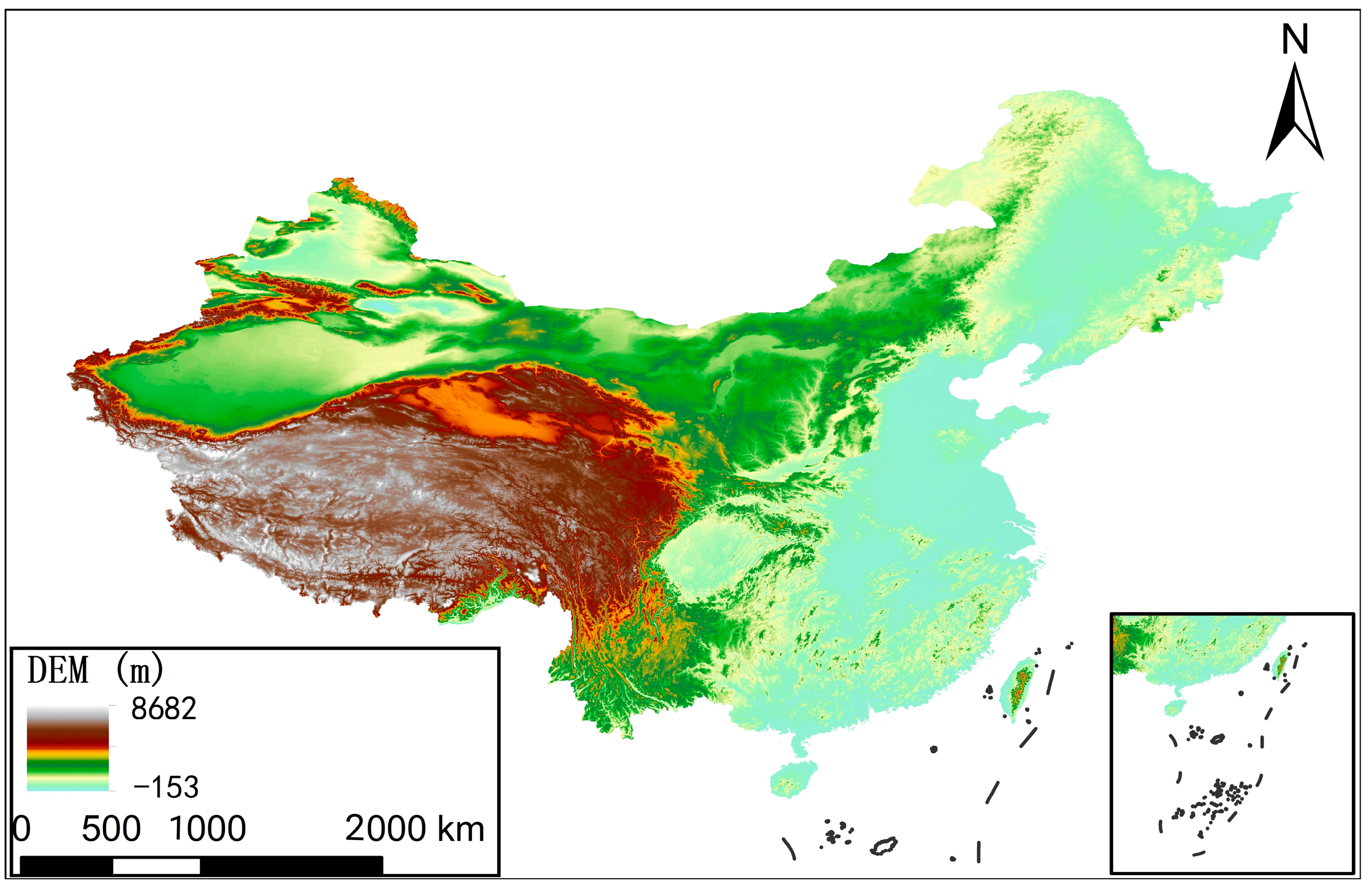
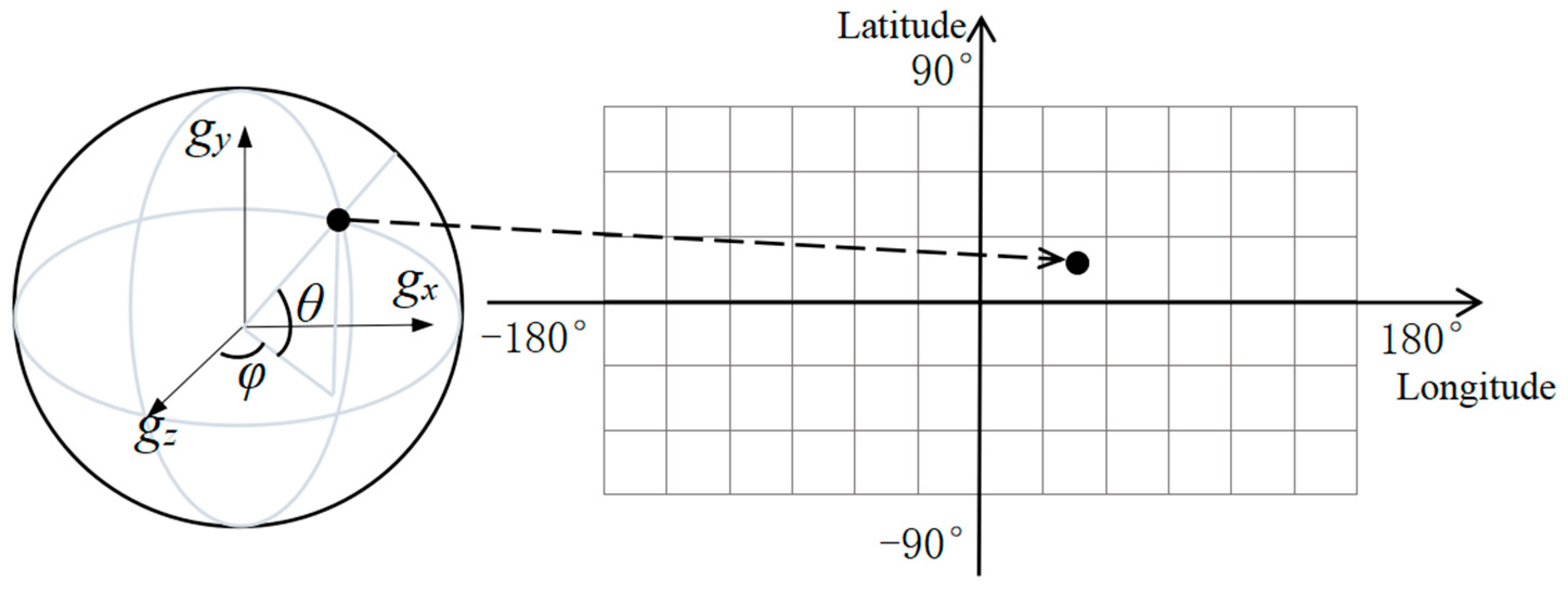
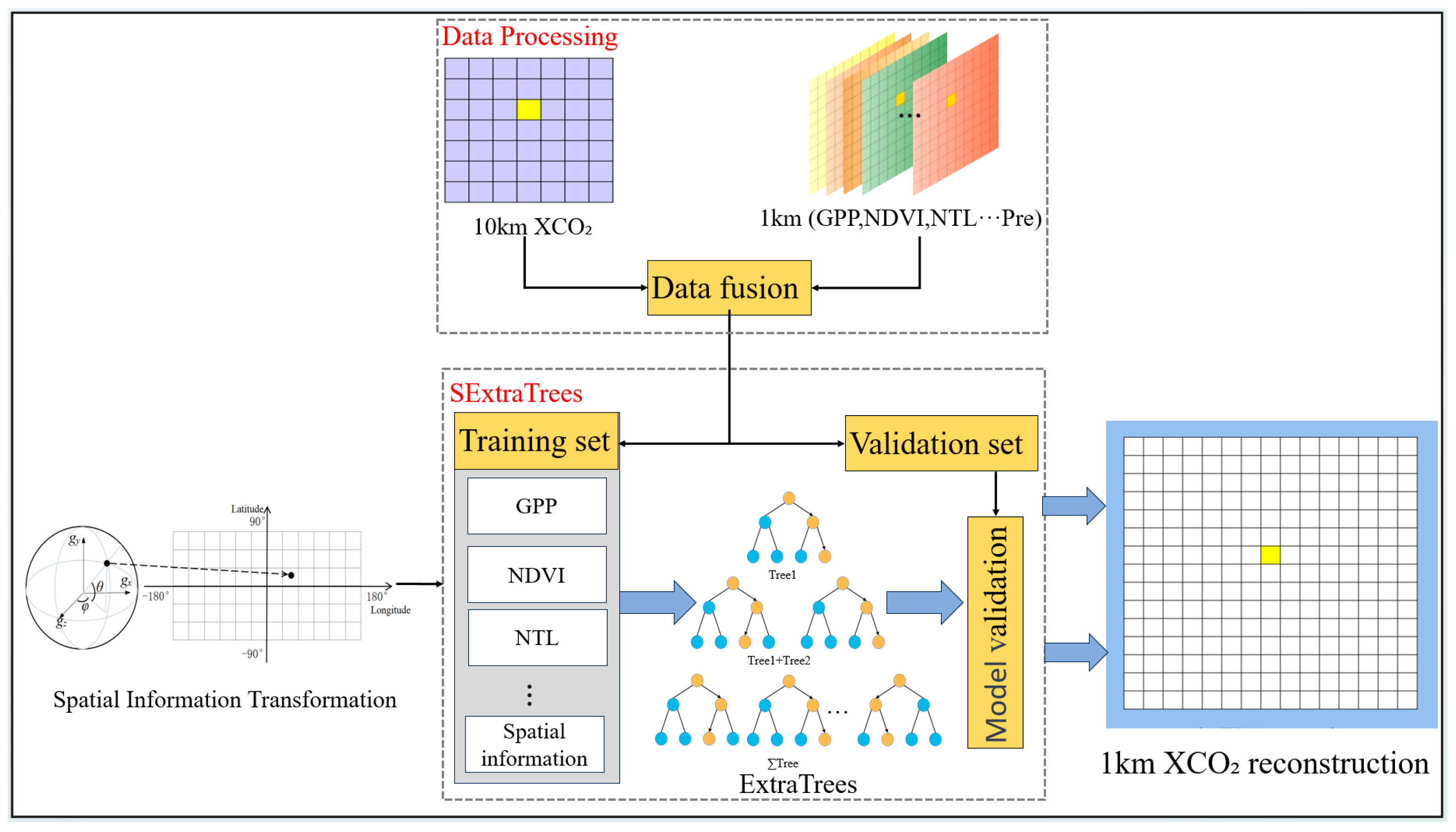
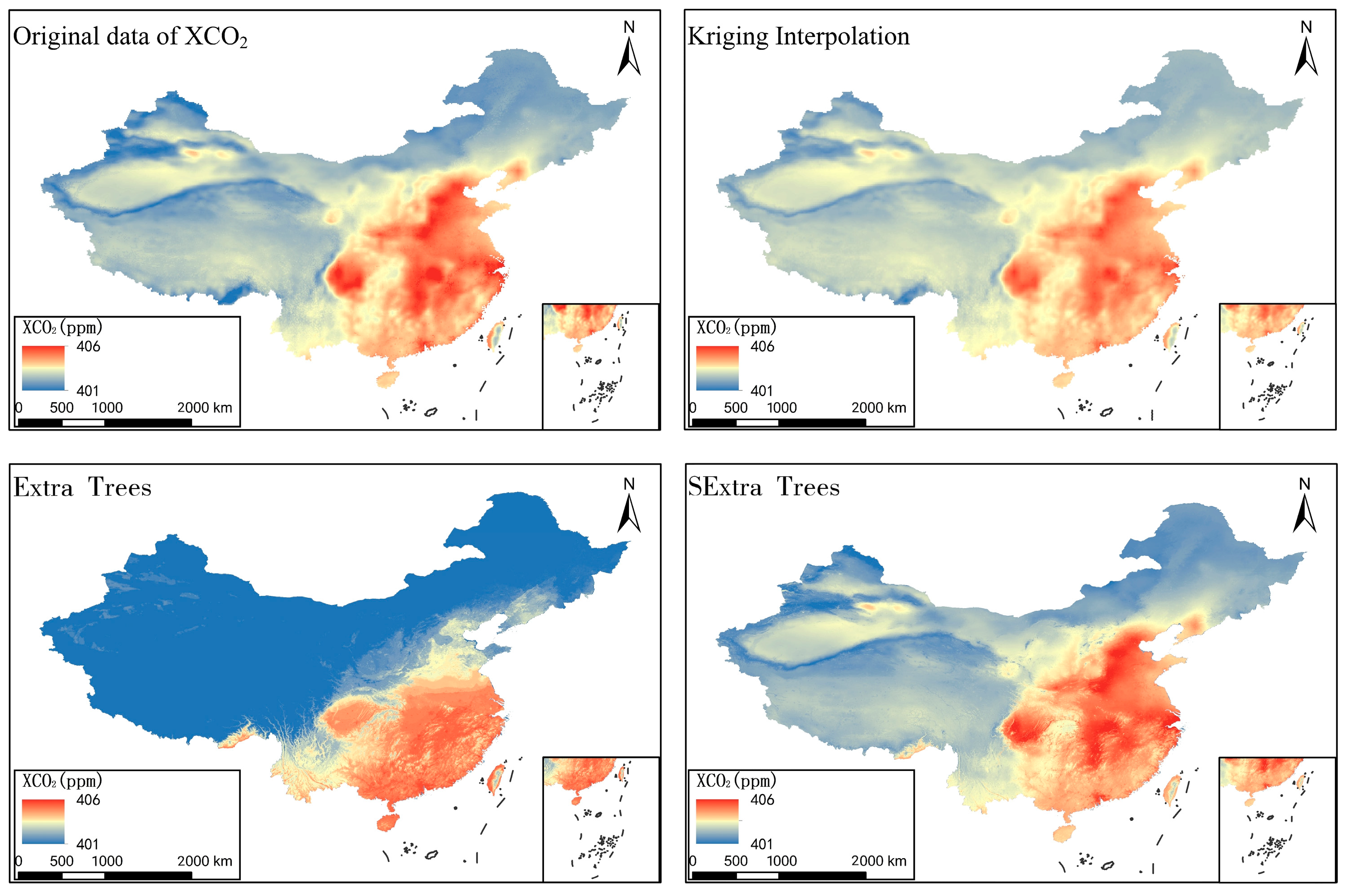
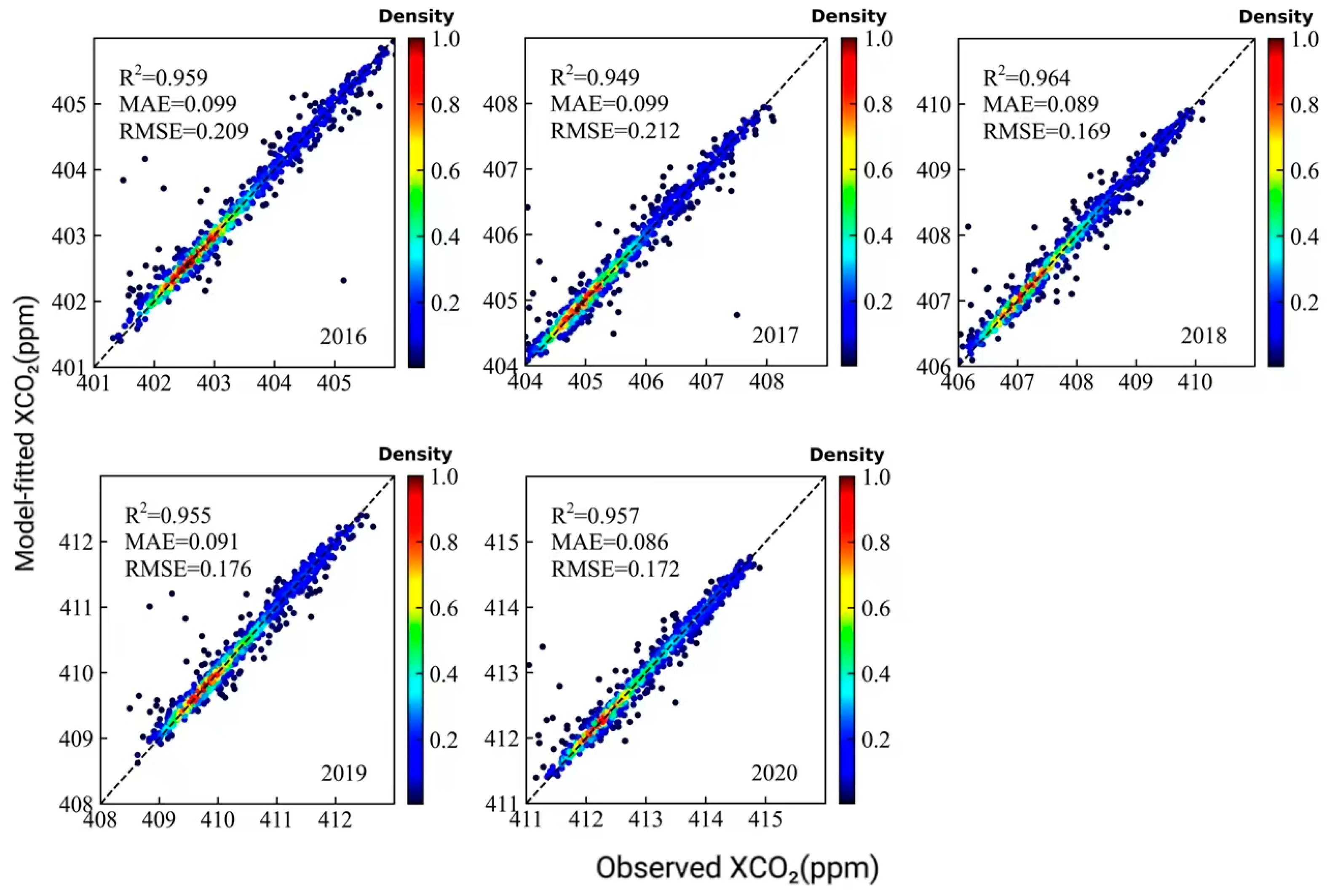
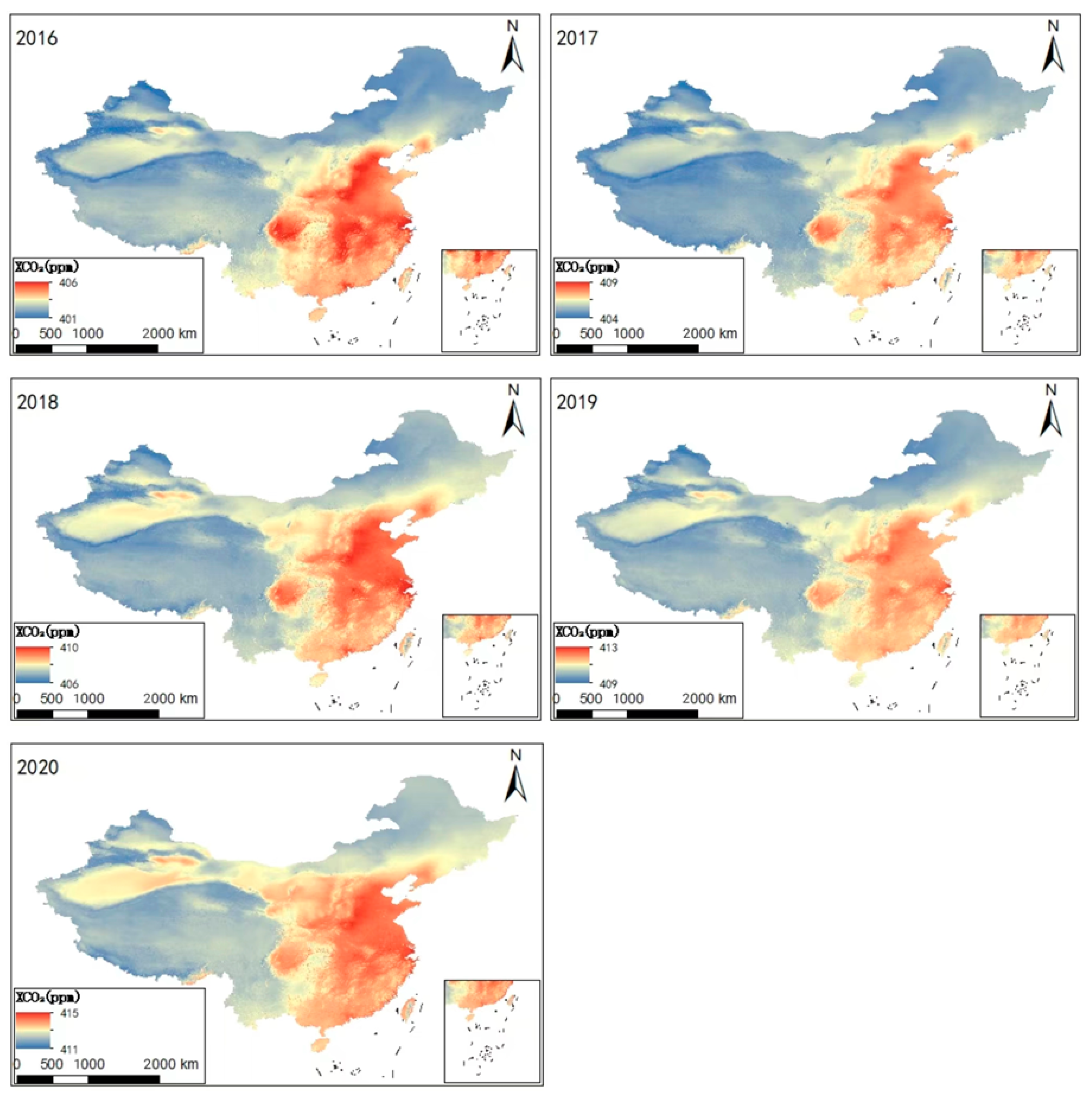

| Variable | Spatial Resolution | Source | Website |
|---|---|---|---|
| DEM | 1 km × 1 km | Resource and Environmental Science Data Center | https://www.resdc.cn (accessed on 10 February 2024) |
| GPP | 5 km × 5 km | Global Ecology Group | https://globalecology.unh.edu/ (accessed on 10 February 2024) |
| NDVI | 1 km × 1 km | Resource and Environmental Science Data Center | https://www.resdc.cn (accessed on 10 February 2024) |
| NTL | 1.5 km × 1.5 km | Institute of Remote Sensing and Digital Earth, Chinese Academy of Sciences | https://www.zybuluo.com/novachen/note/1162587 (accessed on 10 February 2024) |
| POP | 1 km × 1 km | Oak Ridge National Laboratory | https://landscan.ornl.gov/ (accessed on 10 February 2024) |
| WND | 1 km × 1 km | Resource and Environmental Science Data Center | https://www.resdc.cn (accessed on 10 February 2024) |
| PRE | 1 km × 1 km | National Earth System Science Data Center | http://loess.geodata.cn/ (accessed on 10 February 2024) |
| TEM | 1 km × 1 km | National Earth System Science Data Center | http://loess.geodata.cn/ (accessed on 10 February 2024) |
| RH | 1 km × 1 km | Resource and Environmental Science Data Center | https://www.resdc.cn (accessed on 10 February 2024) |
| Model | R2 | MAE (ppm) | RMSE (ppm) |
|---|---|---|---|
| Kriging | 0.961 | 0.697 | 0.699 |
| ExtraTrees | 0.939 | 0.726 | 0.866 |
| SExtraTrees | 0.985 | 0.407 | 0.434 |
Disclaimer/Publisher’s Note: The statements, opinions and data contained in all publications are solely those of the individual author(s) and contributor(s) and not of MDPI and/or the editor(s). MDPI and/or the editor(s) disclaim responsibility for any injury to people or property resulting from any ideas, methods, instructions or products referred to in the content. |
© 2024 by the authors. Licensee MDPI, Basel, Switzerland. This article is an open access article distributed under the terms and conditions of the Creative Commons Attribution (CC BY) license (https://creativecommons.org/licenses/by/4.0/).
Share and Cite
Li, X.; Jiang, S.; Wang, X.; Wang, T.; Zhang, S.; Guo, J.; Jiao, D. XCO2 Super-Resolution Reconstruction Based on Spatial Extreme Random Trees. Atmosphere 2024, 15, 440. https://doi.org/10.3390/atmos15040440
Li X, Jiang S, Wang X, Wang T, Zhang S, Guo J, Jiao D. XCO2 Super-Resolution Reconstruction Based on Spatial Extreme Random Trees. Atmosphere. 2024; 15(4):440. https://doi.org/10.3390/atmos15040440
Chicago/Turabian StyleLi, Xuwen, Sheng Jiang, Xiangyuan Wang, Tiantian Wang, Su Zhang, Jinjin Guo, and Donglai Jiao. 2024. "XCO2 Super-Resolution Reconstruction Based on Spatial Extreme Random Trees" Atmosphere 15, no. 4: 440. https://doi.org/10.3390/atmos15040440
APA StyleLi, X., Jiang, S., Wang, X., Wang, T., Zhang, S., Guo, J., & Jiao, D. (2024). XCO2 Super-Resolution Reconstruction Based on Spatial Extreme Random Trees. Atmosphere, 15(4), 440. https://doi.org/10.3390/atmos15040440






